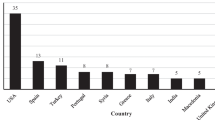Abstract
Background and aims
To elicit mechanisms and timing of sinus development, the role of age at onset of symptoms, symptomatic disease duration, and consecutive number of sinuses were investigated.
Materials and methods
Analysis of 1,962 medical records of patients admitted for primary surgical pilonidal sinus treatment.
Results
Sinus number ranged from 1 to 16 (median 2), with chronic pilonidal disease showing more sinuses than acute disease (mean 2.6 vs 2.1 sinuses; p < 0.0001; Kolmogorov–Smirnov). Disease duration in chronic pilonidal disease was not linked to sinus formation (p = 0.98; Spearman). In acute pilonidal disease, duration was linked to the development of six sinuses per 1,000 symptomatic disease years (p = 0.0001; Spearman). A larger sinus number correlated with earlier onset of symptoms (p = 0.009; Spearman).
Conclusion
Long-standing chronic disease does not produce sinus per se. As sinus does not substantially arise during the course of symptomatic disease, there must be a time before the start of symptomatic disease when the sinus originates.
These findings suggest that sinus can only be acquired up to a certain age, even if occupational exposure continues.



Similar content being viewed by others
References
Bascom J (1983) Pilonidal disease: long-term results of follicle removal. Dis Colon Rectum 26:800–807
Brearley R (1955) Pilonidal sinus; a new theory of origin. Br J Surg 43:62–68
Karydakis GE (1973) New approach to the problem of pilonidal sinus. Lancet 2:1414–1415
Karydakis GE (1992) Easy and successful treatment of pilonidal sinus after explanation of its causative process. Aust N Z J Surg 62:385–389
Page BH (1969) The entry of hair into a pilonidal sinus. Br J Surg 56:32
Stelzner F (1984) Causes of pilonidal sinus and pyoderma fistulans sinifica. Langenbecks Arch Chir 362:105–118
Akinci OF, Bozer M, Uzunkoy A, Duzgun SA, Coskun A (1999) Incidence and aetiological factors in pilonidal sinus among Turkish soldiers. Eur J Surg 165:339–342
Dahl HD, Henrich MH (1992) Light and scanning electron microscopy study of the pathogenesis of pilonidal sinus and anal fistula. Langenbecks Arch Chir 377:118–124
Stephens FO, Stephens RB (1995) Pilonidal sinus: management objectives. Aust N Z J Surg 65:558–560
Franckowiak JJ, Jackman RJ (1962) The etiology of pilonidal sinus. Dis Colon Rectum 5:28–36
Nazarian PA (1987) Mass screening of adolescents with epithelial pilonidal cysts. Sov Med 72–76
Powell KR, Cherry JD, Hougen TJ, Blinderman EE, Dunn MC (1975) A prospective search for congenital dermal abnormalities of the craniospinal axis. J Pediatr 87:744–750
Dumic M, Cvitkovic M, Letinic D, Filipovic-Grcic B, Kordic R (1994) The Dubowitz syndrome. Lijec Vjesn 116:135–137
Yucesan S, Dindar H, Olcay I, Okur H, Kilicaslan S, Ergoren Y, Tuysuz C, Koca M, Civilo B, Sen I (1993) Prevalence of congenital abnormalities in Turkish school children. Eur J Epidemiol 9:373–380
Efrat Z, Perri T, Meizner I, Chen R, Ben-Rafael Z, Dekel A (2001) Early sonographic detection of a ‘human tail’: a case report. Ultrasound Obstet Gynecol 18:534–535
Dwight RW, Maloy JK (1953) Pilonidal sinus; experience with 449 cases. N Engl J Med 249:926–930
Sondenaa K, Andersen E, Nesvik I, Soreide JA (1995) Patient characteristics and symptoms in chronic pilonidal sinus disease. Int J Colorectal Dis 10:39–42
Dogru O, Camci C, Aygen E, Girgin M, Topuz O (2004) Pilonidal sinus treated with crystallized phenol: an eight-year experience. Dis Colon Rectum 47:1934–1938
Allen-Mersh TG (1990) Pilonidal sinus: finding the right track for treatment. Br J Surg 77:123–132
Solla JA, Rothenberger DA (1990) Chronic pilonidal disease. An assessment of 150 cases. Dis Colon Rectum 33:758–761
Kitchen PR (1982) Pilonidal sinus: excision and primary closure with a lateralised wound—the Karydakis operation. Aust N Z J Surg 52:302–305
Kaymakcioglu N, Yagci G, Simsek A, Unlu A, Tekin OF, Cetiner S, Tufan T (2005) Treatment of pilonidal sinus by phenol application and factors affecting the recurrence. Tech Coloproctology 9:21–24
Acknowledgment
This manuscript fully consists of original material, which has not been published or submitted to another journal. All authors declare that they participated in the study as specified below and that they have seen and approved the final version.
Conflict of interest statement
None of the authors has any conflicts of interest. No funds/grants/company gifts have been received, nor has the article been written by a third party.
Author information
Authors and Affiliations
Corresponding author
Rights and permissions
About this article
Cite this article
Doll, D., Friederichs, J., Dettmann, H. et al. Time and rate of sinus formation in pilonidal sinus disease. Int J Colorectal Dis 23, 359–364 (2008). https://doi.org/10.1007/s00384-007-0389-5
Accepted:
Published:
Issue Date:
DOI: https://doi.org/10.1007/s00384-007-0389-5




